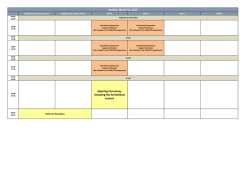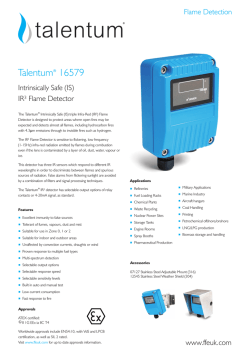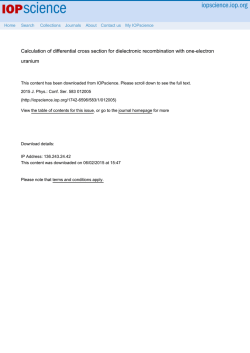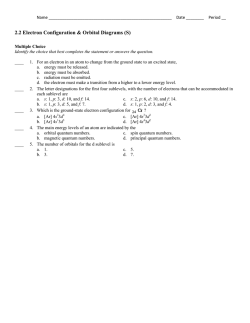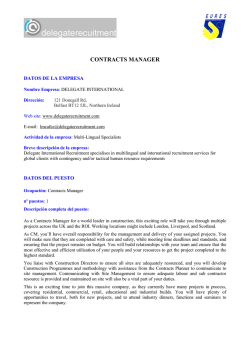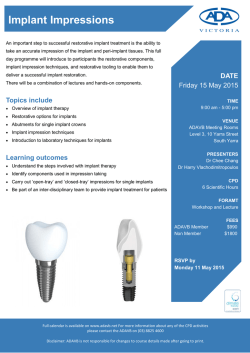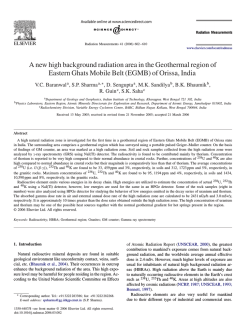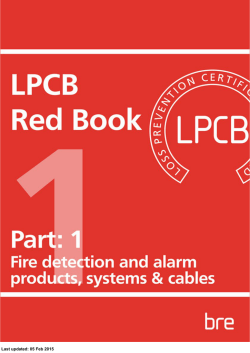
A new measurement of the elastic cross section at
Physics Letters B 545 (2002) 57–61 www.elsevier.com/locate/npe A new measurement of the ν e e− elastic cross section at very low energy C. Amsler d , M. Avenier a , C. Broggini c,∗ , J. Busto b , C. Cerna c , Z. Daraktchieva b , G. Gervasio b , P. Jeanneret b , G. Jonkmans b , D.H. Koang a , J. Lamblin a , D. Lebrun a , O. Link d , F. Ould-Saada d , G. Puglierin c , A. Stutz a , A. Tadsen c , J.L. Vuilleumier b a Institut des Sciences Nucléaires, IN2P3/CNRS-UJF, 53 Avenue des Martyrs, F-38026, Grenoble, France b Institut des Physique, rue A.L. Breguet 1, CH-2000, Neuchâtel, Switzerland c Istituto Nazionale di Fisica Nucleare, Sezione di Padova, via Marzolo 8, I-35131 Padova, Italy d Physik Institut, Winterhurerstrasse 190, CH-8057 Zürich, Switzerland Received 3 July 2002; received in revised form 25 July 2002; accepted 31 July 2002 Editor: L. Rolandi Abstract We have built a low background detector, a time projection chamber surrounded by an active anti-Compton, to measure the ν e e− elastic cross section down to the antineutrino energy of 900 keV. With our detector, running at 18 m from the core of a nuclear reactor in Bugey, we could detect reactor antineutrinos by measuring both the energy and the direction of the recoiling electrons. We report here on a first analysis of the data using an automatic scanning procedure. The results we obtain are 1.5σ higher than the ones predicted by the standard model. 2002 Elsevier Science B.V. All rights reserved. PACS: 13.15; 14.60.5; 26.65; 96.60.J; 29.40.G Keywords: Neutrino–electron scattering; Neutrino properties; Solar neutrinos 1. The experiment MUNU was designed to study ν e e− → ν e e− scattering with the antineutrinos from a nuclear reactor. Technical details of MUNU have already been reported [1,2]. * Corresponding author. E-mail address: [email protected] (C. Broggini). Briefly, the detector consists of a 1 m3 cylindrical time projection chamber (90 cm diameter and 162 cm long) filled with CF 4 at the pressure of 3 bar. CF 4 was chosen because it has at the same time a low atomic number and a high density (3.7 gr/l at 1 bar pressure and room temperature). The z coordinate along the TPC axis is determined by the drift time. The transverse x and y coordinates are obtained with two planes of 256 orthogonal strips. The acrylic vessel TPC is mounted inside a steel vessel (2 m diameter and 3.8 m long) filled with 10 m3 0370-2693/02/$ – see front matter 2002 Elsevier Science B.V. All rights reserved. PII: S 0 3 7 0 - 2 6 9 3 ( 0 2 ) 0 2 5 6 0 - 1 58 C. Amsler et al. / Physics Letters B 545 (2002) 57–61 Thanks to the tracking capability of the detector we have a simultaneous measurement of signal plus background events in the forward solid angle (along the antineutrino direction) and background events only in the backward one. Background can thus be measured on-line, while the reactor is on, and subtracted. The detector is running at 18 m from the core of a 2800 MW power reactor in Bugey, at a depth equivalent to 20 meter of water. The antineutrino flux, 1.2 × 1013 cm−2 s−1 at the detector location, increases rapidly below 1 MeV and is negligible above 10 MeV. To the flux we assign a total error of 5%, which takes into account both the error on the measured spectrum above 1.8 MeV [3] and the estimated error in the energy region from 900 keV to 1.8 MeV [4]. Fig. 1. 860 keV electron (37 cm range): xz (top) and yz (bottom) projections. The binning is 3.5 mm for x and y and 1.8 mm for z, corresponding to 80 ns drift time bins. 2. Event rate of liquid scintillator. The liquid scintillator, read out by 48 photomultipliers (20 cm diameter), works as a muon veto and as an anti-Compton shielding. It gives 134 ± 8 photoelectrons for a 1 MeV energy deposition. The steel vessel is surrounded by 8 cm thick boron loaded polyethylene shielding and a 15 cm thick lead shielding to absorb external neutrons and γ rays entering the detector from outside. Since the expected event rate is low it has been necessary to minimize all possible background sources and to construct each part of the detector from selected low radioactivity material. The electrons of the TPC filling gas (1.06 × 1027 ) are the target for ν e e− scattering. In each interaction the direction of the recoiling electron can be reconstructed, together with its energy (Fig. 1). Because of the scintillation properties of CF 4 [2] the electron energy is obtained not only from the charge collected at the TPC anode plane but also from the amplified light emitted at the anode plane and detected by the photomultipliers which read out the liquid scintillator (the electron primary scintillation light is too faint to be seen in our detector because of the acrylic wavelength cut below ∼400 nm). The energy resolution provided by the two different methods is very similar. The counting rate of the anti-Compton above 100 keV is 700 s−1 : 400 due to natural radioactivity and 300 from cosmic muons. Both rates are in agreement with the measured radioactive contaminants [1] and the muon flux (32 m−2 s−1 ). The rate of the events we are interested in, i.e., electrons in the TPC not due to Compton scattering from gamma rays, needs a more detailed discussion. First the neutrino trigger acquires the events which have an energy deposition larger than 300 keV in the TPC and have not produced any light signal above 90 keV in the anti-Compton during the 80 µs which precede the start of the TPC event (the ‘length’ of the TPC amounts to 75 µs). The Compton suppression efficiency of the neutrino trigger is more than 99.99% for external γ rays. The actual neutrino trigger rate is 0.9 Hz with a 40% dead time, mostly due to event writing to disk. In this Letter we give the results obtained with the data collected in the year 2001, after the detector improvement made the year before [2]. They refer to 68 live days with reactor on and 23 days with reactor off. We apply a 700 keV cut on the electron kinetic energy, which corresponds to neutrino energies larger than 900 keV. This way we are above the end-point energy from the β decay of 85 Kr, which, with an C. Amsler et al. / Physics Letters B 545 (2002) 57–61 estimated activity of 0.15 Bq, is probably the most severe background source at low energy. 3. Data analysis A track recognition program finds the events with one contained electron and fits the vertex and the direction of the track with 80% efficiency. The energy and angular r.m.s. resolution of the detector, measured with radioactive sources, amounts to 10% and 16 degrees, respectively, at 700 keV (7% and 12 degrees at 1.2 MeV). The detector containment efficiency varies from 57% at 700 keV to 35% at 1.2 MeV. The event rate of single reconstructed electrons fully contained inside the TPC volume is 303.6 ± 2.1 counts per day (cpd), i.e., 27 cpd/kg, very close to the rate of very well shielded ultra-low-background germanium detectors operating in an underground laboratory [5]. From the energy spectrum and angular distribution of the electrons we conclude that more than 90% of the background is due to the β decay of the 210 Bi nuclei implanted on the anode plane; 20 cpd are from the radon in the gas (2 mBq) whereas about 2 cpd can be ascribed to external γ rays. The events, stored as a function of the electron energy and scattering angle, undergo two different types of analysis: forward–backward and kinematic one. The key point exploited by the two analysis is the forward–backward symmetry of both the detector and the background (as compared to the antineutrino direction). 3.1. Forward–backward analysis From the Monte Carlo simulation we expect that 33% of the ν e e− scattering events are in the cos(θ ) region between 0.8 and 1 (where θ is the angle between the antineutrino and the electron directions). Such a spread comes from the shape of the differential cross section, the angular resolution of the detector, the track reconstruction algorithm, the size of the reactor core and the unknown absolute z position of the interaction vertex. In the forward solid angle region, 0.8 cos(θ ) 1, the rate is 19.7 ± 0.5 cpd, as compared to 17.9 ± 59 0.5 cpd in the backward one, −1 cos(θ ) −0.8. The difference between the two gives a rate of 1.8 ± 0.7(stat) cpd. To prove that these events are due to antineutrino interactions we have first to show that the background is forward–backward symmetric when the reactor is off. The detector is absolutely symmetric by construction with regards to the reactor–detector axis. For instance, the intrinsic radioactivity of each of the pieces used for the TPC vessel construction has been measured by neutron activation and all the resistors connecting the field shaping rings of the TPC are mounted in the plane perpendicular to the reactor–detector axis. The electrons from a beta contamination on the inner surface of the TPC walls would be suppressed by the TPC fiducial volume cut (no hits within 3 cm from the TPC walls), whereas a gamma ‘hot spot’ on the anti-Compton vessel is excluded because of the uniform count rate of the anti-Compton along the z direction. As final check we make the same analysis with the data taken during the reactor off period. The rate we obtain, 0.1 ± 1.4 cpd, is fully consistent with zero. We have now to prove that the event excess with reactor on is due to ν e e− → ν e e− . To achieve this result we have considered and excluded the following background: • ν e + p → e+ + n in the TPC gas. It is non-existent because there are no free protons in pure CF 4 and the event would be in any case vetoed due to the gamma rays from the positron annihilation. In addition, the reaction is isotropic, apart from a small positron backward asymmetry; • ν e + p → e+ + n in the TPC acrylic vessel. They do take place but they are removed by the TPC fiducial volume cut; • events due to neutron capture. About 52000 neutrons per day are produced by ν e + p → e+ + n in the liquid scintillator and in the acrylic vessel. Neutrons can then be captured either by hydrogen, giving a 2.2 MeV gamma ray followed by a possible Compton inside the TPC, or by a fluorine nucleus of CF 4 , giving an electron from the beta decay of 20 F. Such events give rise to less than 0.3 cpd with an isotropic angular distribution inside the TPC [1]. 60 C. Amsler et al. / Physics Letters B 545 (2002) 57–61 Fig. 2. Spectrum of the forward minus backward electrons above 700 keV as compared to the one predicted by the weak interaction. Moreover, the reactor associated neutron flux in the Bugey laboratory has been evaluated in a previous experiment and found to be negligible [6]. We can now ascribe the event excess with reactor on to ν e e− elastic scattering and compare the measured signal, 1.8 ± 0.7 cpd, to the one expected from weak interaction: 0.71 ± 0.05 cpd. The Monte Carlo error comes from uncertainties in the antineutrino flux and spectrum (5%), track reconstruction (3%), electron containment (3%) and target electron density (1%). In Fig. 2 we compare also the measured spectrum to the predicted one. We conclude that our result is ∼1.5 standard deviations higher than predicted but compatible with weak interactions. There is so far no evidence for a finite neutrino magnetic moment. We observe that our result is in agreement with the one of Reines and collaborators [7], which, with a 1.5 MeV threshold on the electron kinetic energy, is still the best documented one. Actually the analysis of Vogel and Engel [8] shows that they also got a result 1–2σ above the weak prediction. 3.2. Kinematic analysis From the electron energy and scattering angle we reconstruct the antineutrino energy. The electron energy threshold corresponds to a minimum cos(θ ) cut of 0.64. For positive values the event enters the kinematic forward spectrum, else we swap the sign Fig. 3. Spectrum of the kinematic forward minus backward electrons as compared to the ones predicted by the weak interaction (squares) and by the weak plus electromagnetic interactions (triangles) assuming a magnetic moment of 2 × 10−10 Bohr magnetons. of cos(θ ) and for positive antineutrino energy the event enters the kinematic backward spectrum. The difference between the forward and the backward distributions is given in Fig. 3. The integrals of the forward and backward spectrum are 44.7 ± 0.8 cpd and 41.9 ± 0.8 cpd, respectively. Their difference, 2.8 ± 1.1 cpd, gives the number of reactor events. Also in this analysis we find that this difference with reactor off is consistent with zero: −0.9 ± 2.1 cpd. We now compare the measured signal, 2.8±1.1 cpd, with the one expected from the weak interaction: 1.19 ± 0.08 cpd. Our result is ∼1.5σ higher than the expected weak one. Fig. 3 shows the measured and predicted spectra. A χ 2 analysis is also performed which is sensitive to the measured spectrum, as compared to predicted one. This way we are sensitive both to the integral and 2 of 9.6 to the shape of the spectrum. We find a χmin over 10 degrees of freedom corresponding to an upper limit to the antineutrino magnetic moment of 2.3 × 10−10 Bohr magnetons (90% C.L., Fig. 3). Such a value is the consequence of the somewhat larger cross section we measure for elastic ν e e− scattering. Our limit is larger than the one obtained with a reactor on-off analysis in the Rovno experiment, 1.9 × 10−10 Bohr magnetons [9]. However, our signal to noise ratio is one order of magnitude better. C. Amsler et al. / Physics Letters B 545 (2002) 57–61 The best existing limit is the astrophysical one of 0.02 × 10−10 Bohr magnetons, which is coming from the red giant luminosity [10] and which is not model independent. Equally model dependent, this time on the oscillation scenario used, is the limit of 1.5 × 10−10 Bohr magnetons obtained from the shape of the solar neutrino spectrum in Superkamiokande [11]. 61 track reconstruction program, which exploits the experience gained from further detailed hand scanning of the events, is now under development. Better acceptance, higher background rejection efficiency and thus smaller errors are expected. References 4. Summary and conclusions Thanks to the tracking capability of our detector we were able to measure both the angle and the energy of the recoil electron and to extract the reactor signal by subtracting the background measured at the same time as the signal. For antineutrino energies higher than 900 keV (corresponding to electron energies above 700 keV) our result is compatible with the predicted weak rate, even if 1.5σ higher. An improved background rejection and [1] [2] [3] [4] [5] [6] [7] [8] [9] [10] [11] C. Amsler, et al., Nucl. Instrum. Methods A 396 (1997) 115. M. Avenier, et al., Nucl. Instrum. Methods A 482 (2002) 408. Y. Declais, et al., Phys. Lett. B 338 (1994) 383. V.I. Kopeikin, et al., Phys. At. Nucl. 60 (1997) 172. L. Baudis, et al., Phys. Rev. Lett. 83 (1999) 41. M. Abbes, et al., Nucl. Instrum. Methods A 374 (1996) 164. F. Reines, et al., Phys. Rev. Lett. 37 (1976) 315. P. Vogel, J. Engel, Phys. Rev. D 39 (1989) 3378. A.I. Derbin, et al., JETP 57 (1993) 768. G. Raffelt, Phys. Rev. Lett. 64 (1990) 2856. J.F. Beacom, P. Vogel, Phys. Rev. Lett. 83 (1999) 5222.
© Copyright 2025

